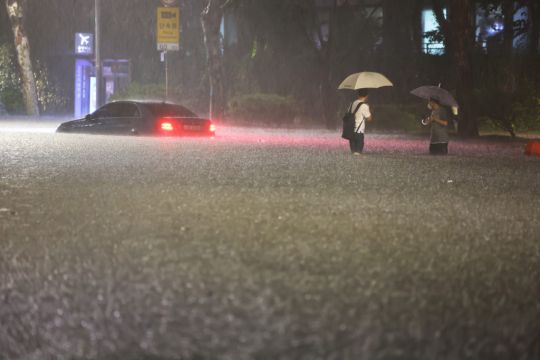At least nine people have been killed and six others are missing after heavy rain hit South Korea’s capital.
The rainfall turning the streets of Seoul’s affluent Gangnam district into rivers, leaving submerged vehicles and overwhelming public transport systems.
Commuters slowly returned to work on Tuesday morning after emergency crews worked overnight to clean up much of the mess but there were concerns about further damage as torrential rain was forecast for the second day in a row.
While most of Seoul metropolitan area’s subway services were back to normal operations, dozens of roads and riverside parking lots remained closed due to safety concerns.

President Yoon Suk Yeol called for public employers and private companies to adjust their commuting hours and urged aggressive action in restoring damaged facilities and evacuating people in danger areas to prevent further deaths.
Moon Hong-sik, spokesperson for Seoul’s Defence Ministry, said the military was prepared to deploy troops to help with recovery efforts if requested by cities or regional governments.
The rain began on Monday morning and intensified through the evening hours. Nearly 800 buildings in Seoul and nearby cities were damaged while at least 790 people were forced to evacuate from their homes, the Ministry of the Interior and Safety said.
People were seen wading through thigh-high waters on Monday night in streets near the Gangnam subway station, one of Seoul’s most bustling business and leisure districts, where passenger cars, taxis and buses were stuck in mud-brown waters.
Commuters evacuated as water cascaded down the stairs of the Isu subway station like a waterfall. In the nearby city of Seongnam, a rain-weakened hillside collapsed on to a university football field.
Rescue workers failed to reach three people who called for help before drowning in a basement home in the Gwanak district of southern Seoul on Monday night.

Another woman drowned at her home in the nearby Dongjak district, where a public worker died while clearing up fallen trees, likely from electrocution.
Three people were found dead in the debris of landslides and a collapsed bus station in the nearby cities of Gwangju and Hwaseong.
Four people went missing in southern Seoul’s Seocho district, which is also home to the private residence of Mr Yoon, who, according to his office, spent hours on the phone receiving briefings and issuing instructions overnight as the rain flooded some of the streets near his high-rise apartment complex.
“The heavy rainfall is expected to continue for days … we need to maintain our sense of alert and respond with all-out effort,” Mr Yoon said during a visit to the government’s emergency headquarters in Seoul on Tuesday.
He directed officials’ attention to areas vulnerable to landslides or flooding and to reducing the dangers of roads and facilities already damaged.
More than 43cm (17in) of rain were measured in Seoul’s hardest-hit Dongjak district from Monday to noon on Tuesday.
The per-hour precipitation in that area exceeded 14cm (5.5in) at one point on Monday night, which was the highest hourly downpour measured in Seoul since 1942.
Rainstorms also pounded North Korea, where authorities issued heavy rain warnings for the southern and western parts of the country.
The North’s official Rodong Sinmun newspaper described the rain as potentially “disastrous” and called for measures to protect farmland and prevent flooding on the Taedong river, which flows through the capital, Pyongyang.







